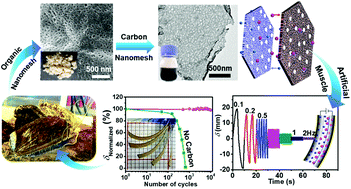Nacre-based carbon nanomeshes for a soft ionic actuator with large and rapid deformation†
Abstract
Marine molluscs have inspired to construct robust composites with hierarchical microstructures, and also to design artificial muscles with rapid and controllable deformation. Abalone nacre has the unique “brick and mortar” structure, whose two-dimensional (2D) “mortar” can serve both as the strong adhesive between aragonite platelets and as the raw material for organic and carbon nanomeshes applicable in a soft ionic actuator. Through an optimal production procedure, carbon nanomeshes with abundant micropores (0.7–2 nm) and in-plane mesopores (9–13 nm) are produced in a high yield. When incorporated into the actuator electrodes, their large surface area (>625 m2 g−1) and heteroatom doping (>7.5%) ensure to offer large ion storage desired by large deformation. Their in-plane mesopores allow for ion penetration desired by fast actuating kinetics, in contrast to graphene nanosheets that block free ion transportation. The resultant ionic actuator shows a low driving voltage (≤3 V), large deformation strain difference (1.11%), fast actuation (100 s) and air working durability (>104 cycles), being superior to the actuators based on other 2D carbon nanomaterials. Thus, this low-cost and scalable production of carbon nanomeshes offers not only a novel type of biomass-based carbon nanomaterials but also a high-performance electrochemical actuator applicable in soft robotics and smart devices.

- This article is part of the themed collection: Journal of Materials Chemistry C HOT Papers


 Please wait while we load your content...
Please wait while we load your content...